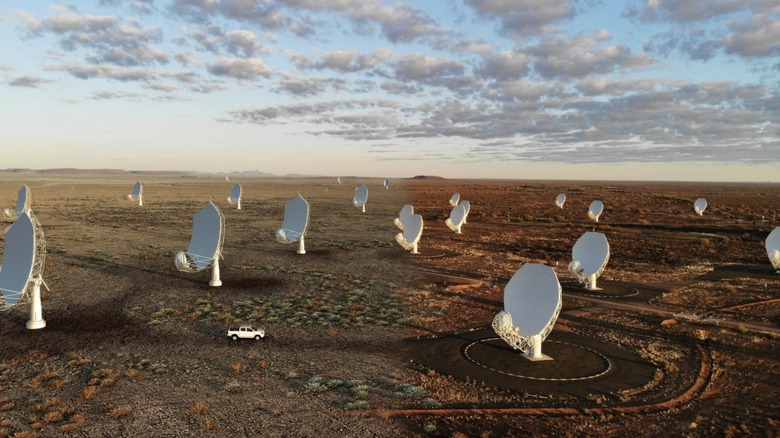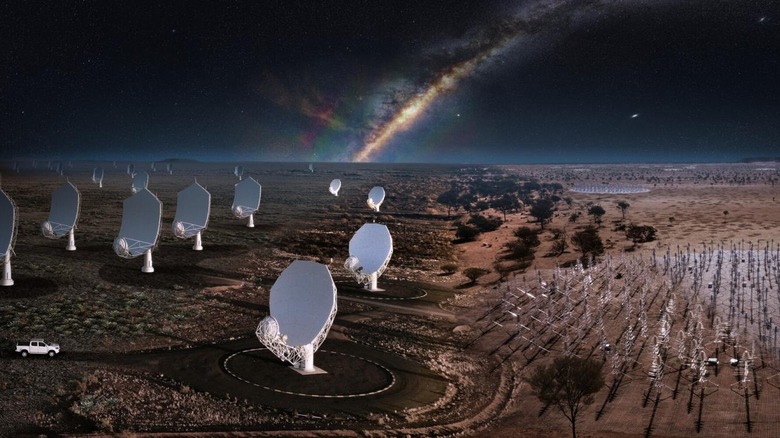Australia, South Africa To Jointly Build The World's Largest Radio Telescope
Following three decades of preparations, construction has finally commenced on the largest radio telescope the world has ever seen. Known as the Square Kilometre Array (SKA), the under-construction telescope is a project with several unique characteristics, the first of which is the fact that it does not match the traditional image of radio telescopes people have in their minds. Unlike conventional radio telescopes that typically consist of a large parabolic dish antenna pointing skywards, the Square Kilometre Array is less impressive to look at. In fact, it is nigh impossible to see all the physical parts of the SKA in one go.
Allow us to explain.
Unlike traditional radio telescopes with their physical elements all in one place, parts of the Square Kilometre Array are separated by vast distances. The SKA is, in fact, the largest example of a physically connected radio telescope. For the uninitiated, physically connected telescopes use an array of smaller antennas that work in unison as a single entity — allowing them to mimic the functionality of a much larger telescope. This method also negates the engineering challenges involved in the construction of traditional radio telescopes that require large parabolic antennas.
While a significant part of the telescope is being constructed in Australia, the other half of the telescope will be located thousands of miles away on a completely different continent, in the country of South Africa. In addition, a third country is involved in the process — the United Kingdom — where all the data collected using the SKA telescope will be processed.
Where are parts of the Square Kilometre Array located?
A significant part of the Square Kilometre Array is located in a remote area in Western Australia. Upon completion of construction, this location will consist of 131,072 small antennas that will give the telescope a combined collection area of 400,000 square meters. This part of the SKA telescope goes by the name SKA-Low because it is specifically designed to detect radio signals that possess very low frequencies. These structures are hardly imposing to look at. However, the combined power of more than 131,072 small antennas exceeds the detection capabilities of more physically imposing radio telescopes.
In addition to the 131,072 small antennas located in Australia, the SKA radio telescope will also include 197 steerable 15-meter dishes dotted across a remote location in South Africa's Karoo region. This element of the SKA telescope is called the SKA-Mid — named after its capability to detect radio signals that fall in the mid-range of the spectrum. The 197 smaller dishes give it a combined collecting area of 33,000 square meters.
Thanks to its massive scale, the SKA will become one of the most sensitive radio telescopes ever made. Besides letting astronomers take a peek into the distant corners of the early universe, the telescope will also help humankind gain deeper insights into the formation of the universe.
What will be the SKA used for?
Dubbed one of the biggest scientific projects of the century, the SKA, upon completion, shall be used to seek answers to several questions that have piqued the interest of astronomers for ages. The incredible sensitivity of the telescope will not only help astronomers gain a better understanding of the universe but will also help them look for signs of alien life on hitherto undiscovered planetary systems. Physicists are also looking forward to using the SKA telescope to perform cosmological measurements and test models of dark energy, gravity, and fundamental cosmology.
The importance of the SKA could be gauged from the fact that its low-frequency array — located in Australia — will be eight times more sensitive than the best radio telescope currently available to detect low frequencies. It will also be 135 times faster than the said telescope when it comes to processing data. The South African wing of the telescope will also be five times more sensitive and 60 times faster than the current best radio telescope for mid-range frequencies.
It will be a while before scientists are able to use the SKA radio telescope, though. Current estimates put the completion of construction by the end of the decade. Once completed, the SKA radio telescope is expected to remain in operation for well over 50 years.


